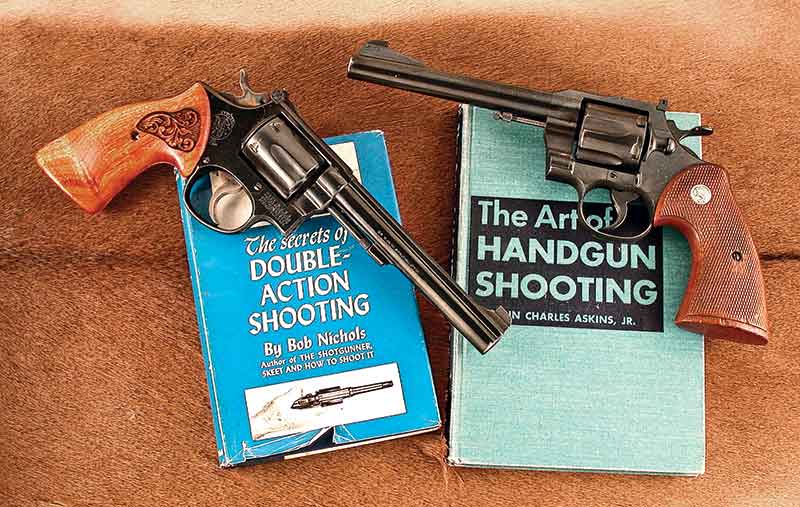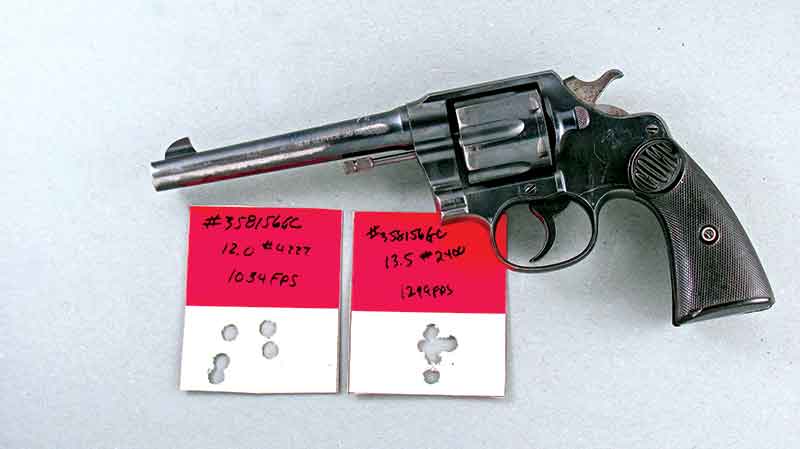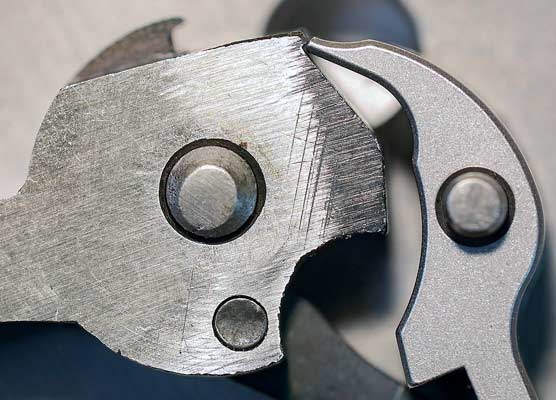Playin' Favorites:
More .38 Special Sixguns
Just as the vast majority of those sixgunners from my era, I started most of my reloading chores in the mid-1950’s with the .38 Special. I did not own a .38 Special at the time but rather a pair of .357 Magnums consisting of a 45/8″ Ruger Blackhawk and a 4″ S&W Highway Patrolman. While it was difficult to find .357 Magnum brass and quite expensive when achieved (I cherished 50 rounds of Norma .357 brass for several years!), .38 Special brass was not only readily available but also quite inexpensive.
I obtained a single cavity Lyman #358429 Keith bullet mold, molded bullets over my mother’s kitchen stove and loaded hundreds upon hundreds of .38/44 loads in .38 Special brass for shooting in my Magnum sixguns. They were all loaded with 13.5 grs. of #2400, which is an extremely hot loading with pressures exceeding most of today’s .357 Magnum factory rounds. After all these years, I still load this round a lot for .357 Magnum sixguns and use it very sparingly in heavy-framed .38 Specials, but mostly use around 12.0 grs. in the latter these days.
The Smith & Wesson Military & Police arrived in 1899 and was destined to be very popular as a law enforcement sidearm for more than half a century. It did not take long for Smith & Wesson to add adjustable target sights to what is now known as the K-Frame platform. The K-38 with a 6″ barrel was destined to become one of the most popular target revolvers of the 20th century. Not only was it used for target shooting, it also became a police sidearm and was soon offered with a 4″ barrel and adjustable sights for police use.
These are superbly shooting medium-framed revolvers for target and standard loaded .38 Specials. For target shooting, the .38 wadcutter was widely used, and shooters found the same sixgun and load also made an excellent close range small game, varmint and pest load. The 148-gr. wadcutter does not move very fast but hits with authority due to its full caliber flat nose. The late Jack Weaver of Weaver Stance fame did most of his shooting, keeping up with or exceeding those with 1911’s, with a 6″ K-38.
Modernizing
In the 1920’s, crime was rampant in this country and police were often outgunned and needed help with more powerful sidearms. Especially needed were loads that would penetrate car bodies as criminals had long since left horses behind and traveled in Ford V-8’s.
Colt’s answer in 1929 was the upgrading of the .38 ACP to the .38 Super chambered in the 1911 using a 130-gr. FMJ at 1,300 fps. Smith & Wesson stayed with a revolver and the .38 Special, however they moved up to a larger frame sixgun using a more powerful .38 Special. The platform was the N-Frame Model 1926 .44 Special fitted with a .38 barrel and cylinder and the result was the .38/44 Heavy Duty, one of the finest double action sixguns of all time. The .38/44 ammunition was approximately 300 fps faster than the standard round-nosed lead .38 Special and was offered in a metal piercing round.
Just as they had done with the original fixed-sighted M&P, Smith & Wesson added target sights to the .38/44 and the result was the 61/2″-barreled .38/44 Outdoorsman. With the arrival of the original .38/44, both Elmer Keith and Phil Sharpe went to work with even heavier loadings. The standard Keith .38/44 load was his 168-gr. cast SWC bullet over 13.5 grs. of #2400. This is an extremely powerful loading and should be used with due caution. Pressures are above some of today’s .357 Magnum rounds, and while I have used this load extensively for my older .38/44’s, I have pretty much dropped back to 12.0 grs., saving the heavier load for use in .357 Magnum sixguns.
The .44 Special Triple-Lock gets all the publicity as the finest sixgun produced by Smith & Wesson, however the .38/44 Outdoorsman was not all that far behind. S&W’s Col. Doug Wesson and Phil Sharpe went to work seriously with the .38/44 and the result in 1935 was the .357 Magnum, which was virtually a hand-built version of the Outdoorsman.
The .38/44 has been out of production since the 1960’s, however, it remains an excellent sixgun whether for double-action shooting or outdoor use. With the Keith bullet over 12.5 grs. of #2400, my circa 1948 Outdoorsman does over 1,200 fps. Switching to the lighter hollowpoint version of #358429 results in 1,350 fps and groups well under 1″. As long as I have a .38/44 Outdoorsman I can get along quite well without a .357 Magnum (not that I want to!).
Colt
Even more popular than the S&W K-38 as a target revolver was the Colt Officers Model Match. Built on the Official Police .41 frame, these sixguns were known for their fine fitting and accuracy. Anyone who has ever cocked a finely tuned Colt realizes how smooth a double action revolver can be. Mine is shot regularly and exclusively with .38 wadcutters and after more than 50 years of service is still capable of match accuracy.
While Smith & Wesson went to a larger frame to come up with a more powerful .38 Special, Colt stayed with their Official Police frame bringing out an adjustable sighted 4″ for police and self defense use. The same frame eventually evolved in the 1950’s to the Colt .357 Magnum and then the magnificent .357 Magnum Python.
Colt’s large-frame, double-action, swing-out cylinder revolver dated back to the 1890’s and was known as the New Service. During WWI this large sixgun was chambered in .45 ACP requiring the use of half-moon clips and was known as the Model 1917. In all the years I’ve been shooting I have been privileged to experience the Colt New Service in .45 ACP, .45 Colt, .44 Special, .44-40 and .38-40.
However, in this time I had never come onto a .38 Special New Service. Prior to WWII these were the issue guns of the Border Patrol but I had never found one at any kind of reasonable price until now. This past spring I walked into the Cabela’s Gun Library and what should I find but an extremely reasonably priced .38 Special New Service. Standard barrel lengths of the other chamberings were 41/2″, 51/2″ and 71/2″, however for some reason this .38 Special not only has a 6″ barrel, but the grip frame is slightly modified from the other standard versions.
Although I’ve mostly shot Smith & Wessons, when it comes to Heavy Duty .38 Specials, this New Service is fast becoming a favored sixgun. It’s every bit as strong as a Smith & Wesson .38/44, and possibly stronger. However, it’s also even older than I am so I approach it with the same caution with handloads as I do the vintage Smith & Wessons. It has been fashionable for many years to consider the .38 Special as not all that much, but being realistic, short of big game hunting, there’s not a whole lot needing to be done with a sixgun that can’t be accomplished with a 158-gr. bullet at 1,200 fps.
Single Actions
Colt Single Action .38 Specials have only been rarely found, and especially so in their 1st Generation run. Several years ago I came up with a 2nd Generation .38 Special, however since it had already been modified I took the next step and turned it into a .44 Special. What has been lacking in personally found Colt SAAs has been filled by .38 Specials from two other single action manufacturers. Colt had stopped manufacturing the Single Action Army in 1940 with a statement it would never return.
Great Western began producing replicas of the Colt in 1954 and these were entirely American-made sixguns from their factory in Los Angeles. They lasted less than 10 years. Today Great Westerns have attained collector status, however 15 years ago I bought two of them for less than the price of one today. One of those was a matte finished 71/2″ .38 Special.
A friend of mine, now gone to his reward, found another GW .38 Special for me with a buggered-up barrel which has since been replaced by the 51/2″ barrel originally on the Colt .38 Special mentioned above. They may not be Colts but I consider them Single Action .38/44 Heavy Duties and I certainly enjoy shooting them, feeding them mostly with loads consisting of the 158-gr. Lyman #358156 Thompson Gas Check cast bullet or the 168 gr. Keith bullet over 12.0 grs. of #2400 for 1,200-1,300 fps.
Several years ago the now gone Shoot Magazine received a 51/2″ USFA Single Action in payment for advertising. No one on the staff wanted it because it was “just a .38 Special.” USFA Single Actions are dead ringers for Colt 1st Generation sixguns and Ed McGivern’s favorite Colt Single Action was a 51/2″ .38 Special. This was the single action sixgun he did all of his speed shooting with in that style. If it was good enough for Ed McGivern it was certainly good enough for me. It’s such a beautiful sixgun it now wears flame-grained exotic wood stocks by Roy Fishpaw. Just as with the Great Western .38 Special, this one exists on the same diet and rides in a vintage S.D. Myers holster when I am out and about.
I can’t fault those who look down their nose at the .38 Special too much, since I did the same thing at one time. As I’ve gotten older I’ve gotten wiser, at least in some aspects.
Want to comment on this article? Drop me a note at [email protected] and let us know what you think!









